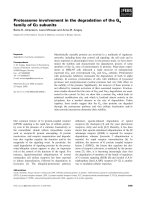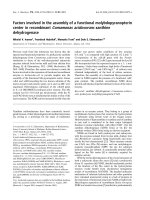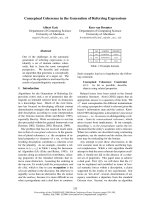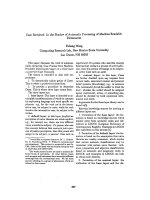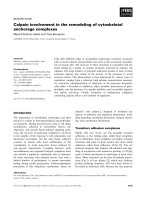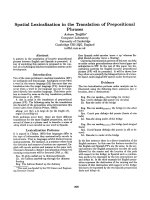Báo cáo toán học: "hree gradients in the architecture of trees." potx
Bạn đang xem bản rút gọn của tài liệu. Xem và tải ngay bản đầy đủ của tài liệu tại đây (26.69 KB, 6 trang )
Original article
Three gradients in the architecture of trees
David Francis Robinson
*
Department of Mathematics and Statistics, University of Canterbury, Private Bag 4800, Christchurch, New Zealand
(Received 1 February 1999; accepted 11 April 2000)
Abstract – An earlier paper by the same author set out a symbolic notation for tree architecture designed to codify the Hallé-
Oldeman tree models. This was used to construct a number of rules of tree architecture with the aim of discovering the limits of tree
architectures. The present paper continues this search with six more rules. Applying the rules reveals eight new models or extensions
of existing models which probably do not exist. Ten of the rules are combined to suggest three gradients, directions in which differ-
ences between trunk and branch axes can occur. There are gradients in in determinacy and tropy of trunk and branch axes and in the
modes by which trunk axes relay, branch axes are attached and branch axes relay.
tree / architecture / model / rule / gradient
Résumé – Trois tendances dans l’architecture des arbres. Un article antérieur par le même auteur a proposé une notation symbo-
lique pour l’architecture des arbres, conçue pour codifier les modèles Hallé-Oldeman des arbres. Cette notation a été utilisée pour
découvrir les limites des architectures des arbres. Ici nous continuons cette recherche avec six règles de plus. En appliquant les règles
nous découvrons huit modèles nouveaux ou extensions des modèles existants qui probablement n’existent pas. Nous combinons dix
des règles de façon à obtenir trois tendances, directions dans lesquelles peuvent se présenter les différences dans la détermination et
le tropisme entre les modules du tronc et des branches, et aussi les différences entre les modes de relais des modules de tronc, d’atta-
chement des branches et de relais des modules des branches.
arbre / architecture / modèle / règle / gradient
1. INTRODUCTION
The architecture of trees can be approached from
many viewpoints, according to the features of trees
which are of greatest importance to the investigator. One
approach is that set out in Hallé and Oldeman [4] but
refined and made more widely known in Hallé, Oldeman
and Tomlinson [5]. The basis of this classification is the
combination of meristematic units (axes) which make up
the trunk and main branches. The axes themselves are
classified in terms of determinacy (determinate, indeter-
minate) and tropy (orthotropic, plagiotropic, orthopla-
giotropic). Axes may spring from other axes terminally,
continuously or diffusely, dichotomously, rhythmically,
zonally or, in the case of trunk axes, basally or under-
ground. The authors found that there were 23 standard
combinations of these features among existing trees,
which they set out as models and assigned to each the
name of an eminent botanist who had some connection
with the recognition of the model or the description of
trees exhibiting that model of growth. Actual trees did
not always conform precisely to these models, growth
always being liable to be modified by environmental or
accidental factors.
This system of architecture received wide acceptance,
the system as a whole being attacked only by Guédès
Ann. For. Sci. 57 (2000) 439–444 439
© INRA, EDP Sciences
* Correspondence and reprints
Tel: 64 3 366 7001; Fax. 64 3 364 2587; e-mail:
D.F. Robinson
440
[3], who proposed an alternative scheme. There were a
few suggestions of further models to accommodate fossil
trees (Beck’s Model, Trivett [8]) and Gay [2] for the fern
Lomogramma guianensis. Philipson and Molloy [6]
described two members of the family Araliaceae which
did not seem to conform to any of the models, but pro-
posed no new models. Cremers and Edelin [1] were
unconvinced by the argument which separated off
Tomlinson’s Model since it is the only case where basal
production of trunks is used to distinguish models. They
proposed its deletion and the assignment of its members
to Holttum’s or Corner’s Model.
In [7] I attempted a symbolic classification of tree
architectures which would be as close as I could devise
to the Hallé-Oldeman system, and would enable us to
ask what other structural possibilities there were and
why they did not happen. The method was to represent
each model by a string of symbols which represented the
determinacy and tropy of trunk axes and branch axes and
their methods of attachment. It proved impossible to
make an exact matching between the strings and the 23
models; some models were represented by alternative
strings and others were distinguished from one another
by features which I had not built into my description.
The framework gave rise to about 2000 possible archi-
tectural strings. These were scanned to find patterns that
did not correspond to any of the 23 models and thus to
identify a number of rules of combination. Nine general
rules, four trunk rules, two branch rules and ten attach-
ment rules, specific to the attachment of branches to the
trunk, were found. Some of these rules were logically
necessary, some codified what appeared to be the case,
but had no obvious basis in necessity. Others lay between
these extremes. Even after excluding the structures which
violated one or more of these rules, there were many
structures expressible that could not be described as
equivalents of the Hallé-Oldeman models. This failure to
exclude everything but the Hallé-Oldeman models left
the research in a somewhat unsatisfactory state. The
notation was also put forward as valuable in its own right
as a framework within which trees could be recorded
without preconceptions as to the existence of models.
The present investigation began as an attempt to elim-
inate all strings which do not correspond to Hallé-
Oldeman models in order to complete the deduction of a
set of suggested constraints on tree growth, in the expec-
tation that this might shed some light on the nature or
organisation of trees, and possibly of plant growth in
general. Six more rules were obtained, as given below.
However, the collection has become unwieldy and we
turn to alternative ways of expressing the constraints.
One of these ways is through three gradients, consistent
directions in which changes, in determinacy, tropy and
attachment and relaying, take place as we move from
tree trunk to branches.
2. MATERIALS AND METHODS
The materials for this investigation are the tree models
as presented by [5] and the analysis of [7].
2.1 Growth axes
Higher plants grow by means of meristems. The shoot
directly produced by a single meristem is an axis. Axes
are of two types: determinate and indeterminate. In
determinate growth the axis terminates either in an abort-
ed bud or in an inflorescence which forms no part of the
growth architecture. In indeterminate growth the axis
continues growing indefinitely. (There are other mean-
ings given to the word “determinate”: in particular
growth in some trees, especially conifers, is said to be
determinate because the whole year’s growth is present
in bud before growth starts ([5] p. 34).)
There are two basic tropies: orthotropic in which the
axes generally grow more or less vertically upwards and
the phyllotaxis is spiral, and plagiotropic in which the
branches grow more or less horizontally and the phyl-
lotaxis, either primarily or secondarily, such as by peti-
ole bending, puts the leaves in a roughly horizontal
plane, making a line down each side of the stem. These
tropies are combined in some shoots, called orthopla-
giotropic which are at first orthotropic in direction and
phyllotaxis and at some point change more or less rapid-
ly to plagiotropic. Branch axes may also be plagiotropic
by apposition or substitution. The axes are basically
orthotropic but are constrained by their position on the
tree into a horizontal direction until, after bearing one or
more branches, the terminal part of the axis turns in an
upward direction. The phyllotaxis is primarily spiral
throughout but secondarily distichous; as the shoot turns
upwards, the spiral phyllotaxis is reasserted. If the shoot
terminates either in an inflorescence or an aborted bud
immediately after the branching the tropy is termed pla-
giotropic by substitution. If the shoot continues vegeta-
tively for a distance, though it may be ultimately
determinate, it is called plagiotropic by apposition.
2.2 Attachment
There are five patterns of attachment of axes to the
axis from which they spring as lateral meristems. In con-
tinuous or diffuse branching the parent axis bears other
axes in an unpatterned way, possibly from every lateral
bud, but more usually only from a few of them. In
Tree architecture gradients
441
dichotomous branching the apical meristem of a shoot
divides evenly in two. In the analysis in [7] this division
is treated as creating two new meristems and so two new
axes. In [5], both are treated as continuations of the same
axis. The growth pattern is very rare and is not accepted
by all researchers. In rhythmic branching growth occurs
in bursts (flushes), usually, especially in regions with a
dormant season, one flush per year. There are can be
more; in Camellia sinensis (tea) there are up to four flush-
es per year. A rhythmic architecture results on indetermi-
nate axes in new axes being produced in groups close to
or at the same level on the parent axis. On determinate
axes the corresponding mode of attachment is terminal.
New axes, which may be relaying trunk axes or branch
axes, arise only near the end of the parent axis. This form
of attachment also occurs in plagiotropy by substitution.
Zonal branching occurs on determinate and indetermi-
nate axes and consists of branching springing from a sin-
gle zone on the parent shoot, generally accompanied by a
change in the direction of the parent axis from more or
less vertical to sloping or horizontal This is typical of
orthoplagiotropic axes, but is not confined to them,
occurring also where axes are orthotropic (Champagnat’s
Model) or plagiotropic (Troll’s Model). The change in
direction is opposite to this, from secondarily plagiotrop-
ic to orthotropic, in plagiotropy by apposition.
To these forms of branching must be added basal
branching, whereby new trunks can spring from the base
of earlier trunks, and underground, whereby new trunks
arise at some distance from the original trunk, as in such
clonal trees as the aspen (Populus tremula). These forms
are used in [5] to distinguish Tomlinson’s Model from
Holttum’s and Corner’s, but also occur in other models,
where they are not necessarily reported.
2.3 Architecture rules
The following architecture rules were developed in
[7]. Rule A7 has been omitted because it is in clear con-
flict with several of the models and must be erroneous.
G7 and A10 have been corrected and B2 and A4 have
been slightly restated. Rule A9 has an exception in that
one version of Prévost’s Model has orthoplagiotropic
trunk axes and branches plagiotropic by substitution. The
asterisks indicate those rules which are summarised by
the three gradients stated later, and the brackets indicate
those rules which are more or less direct consequences
of the definition of the terms.
General rules
(G1) Indeterminate axes do not produce other axes
terminally;
(G2) Basal or underground branching can only be used
to produce trunk axes;
G3 Dichotomous branching never occurs with other
kinds of branching, except basal or underground,
always produces axes of the same tropy as those
branching, and involves only determinate axes;
G4
Determinate axes never bear other axes rhythmically;
G5* Axes produced continuously do not themselves
produce axes rhythmically or zonally;
G6* Axes produced rhythmically do not themselves
produce axes continuously;
G7* Axes produced zonally only bear axes zonally or
terminally;
G8 Orthoplagiotropic axes never produce other axes
dichotomously, terminally or rhythmically;
G9 Determinate orthotropic axes do not bear other
axes zonally.
Trunk rules
(T1) Trunk axes are never produced continuously,
dichotomously or rhythmically;
T2 Trunks do not consist of determinate plagiotropic
axes;
T3 Plagiotropic trunk axes are not produced basally or
underground;
T4 Trunks do not consist of axes plagiotropic by sub-
stitution or apposition.
Branch rules
(B1) Branches with plagiotropy by substitution or appo-
sition always involve terminal or zonal branching;
B2 Mature branch axes give rise to further branch axes
except in some cases when they are plagiotropic.
Attachment rules
A1* Orthoplagiotropic branches are only found with
orthoplagiotropic trunks;
A2* Orthoplagiotropic trunks do not bear orthotropic
branches;
A3* Plagiotropic trunks bear only plagiotropic branches;
A4* Branch axes attached terminally only give rise to
further axes terminally;
A5 Non-orthotropic trunks do not bear branches rhyth-
mically;
A6 Where the trunk is a sympodium of determinate
axes, the branches must be attached in the same
manner as the trunk axes;
A8 Only sympodial trunks relaying zonally bear
branches zonally;
D.F. Robinson
442
A9 Branches attached zonally consist of axes of the
same determinacy and tropy as the trunk axes that
bear them;
A10*
Branches plagiotropic by substitution or apposition
only spring from orthotropic or orthoplagiotropic
trunk axes.
3. RESULTS
3.1 Further rules
Further examination of the tree architectures by the
methods of [7] but taking the features in a different order
resulted in six more rules:
A11 A tree whose trunk is a sympodium relaying by
zonal attachment must have branches (besides the
distal parts of the trunk axes);
A12 Monopodia do not bear branches zonally;
A13* Determinate monopodia do not bear indeterminate
branches;
A14 Indeterminate trunk axes only bear branches con-
tinuously if the trunks are orthotropic;
A15* Indeterminate branch axes are never borne termi-
nally;
T5 Trunks without branches are always orthotropic.
These are certainly not all the rules which could be
extracted from the list of Hallé-Oldeman models. Any
different way of looking at the patterns of occurrence is
likely to produce new observations. Nor does this list
contain sufficient rules to prevent all the non-observed
tree structures, although it does reduce them to manage-
able numbers. A check showed that there were the fol-
lowing survivors, some of which might be assigned to
named models:
(a) Determinate orthoplagiotropic monopodia with
determinate orthoplagiotropic branches continuously
attached: these might be assigned to McClure’s
Model;
(b) Determinate orthoplagiotropic monopodia with con-
tinuously attached determinate branches plagiotropic
by substitution;
(c) Determinate orthotropic monopodia with determi-
nate plagiotropic branches continuously attached,
closest to Stone’s Model;
(d) Determinate orthotropic monopodia with continu-
ously attached determinate branches plagiotropic by
substitution;
(e) Determinate orthotropic monopodia with determi-
nate plagiotropic branches terminally attached and
relaying;
(f) Determinate orthotropic sympodia with indetermi-
nate orthotropic branches terminally attached;
(g) Indeterminate orthotropic monopodia with determi-
nate plagiotropic branches attached rhythmically and
not relaying: this is closest to Cook’s Model;
(h) Indeterminate orthotropic monopodia with determi-
nate plagiotropic branches attached rhythmically and
relaying terminally or zonally.
We have a list of 30 rules which seem to be obeyed by
all trees. Some of these rules will have individual value
in encouraging us to consider why they hold, and so pos-
sibly discovering some deeper regularity or constraint in
the structure of trees or indeed all higher plants.
If we seek meaning in the list as a whole there
remains the task of “seeing the wood for the trees”,
selecting and arranging them into a smaller number of
principles which are more easily grasped by the mind.
3.2 Gradients
Examination of these rules and the symbolic list of
models in [7] suggests gradients in determinacy, tropy
and attachment. That is, as we move from trunk to
branches or from trunk relaying to branch attachment to
branch relaying the determinacy, tropy or attachment
either stays the same or changes in a consistent direction,
not necessarily to the next state.
3.3 Gradient in determinacy
Table I shows the combinations of determinacy in
trunk and branches. If trunk and branches are not of the
same determinacy, it is usually the trunk that is indeter-
minate and the branch axes determinate. Only one ver-
sion of Nozeran’s Model goes in the opposite direction.
Thus we have a gradient from trunk to branches:
indeterminate – determinate.
Table I. Determinacy combinations.
Trunk Branch Models
I – Corner’s, Tomlinson’s
I I Aubréville’s, Massart’s, Roux’s, Cook’s,
Rauh’s, Attims’s, Mangenot’s,
Champagnat’s, Troll’s
I D Fagerlind’s, Petit’s, Roux’s, Cook’s,
Scarrone’s, Stone’s
D D Schoute’s, McClure’s, Leeuwenberg’s,
Koriba’s, Prévost’s, Nozeran’s, Stone’s,
Mangenot’s
D – Holttum’s, Tomlinson’s, Chamberlain’s
D I Nozeran’s
(D = determinate, I = indeterminate, – = absent).
Tree architecture gradients
443
3.4 Gradient in tropy
Trunk and branch axes exhibit the combinations of
tropies shown in table II.
These variations can be summed up in the second gra-
dient:
orthotropic – orthoplagiotropic – plagiotropic –
plagiotropic by apposition or substitution.
3.5 Gradient in relaying and attachment
Basal and underground attachment apply only to trunk
axes and dichotomous branching never occurs with any
other branch attachment type, so these can be set on one
side. We can then draw up the list in table III.
We can combine all these into a third gradient:
continuous or diffuse – rhythmic – zonal – terminal.
4. DISCUSSION
4.1 Missing models
The establishment of the architecture rules has thrown
up the combinations (a) to (h). Examples of them could
be looked for and model descriptions widened or new
models erected to contain them. On the other hand, each
could be examined for indications of non-viability.
4.2 Gradients
But the intended purpose of the rules was to aid the
discovery of basic principles of tree architecture. In this
the rules have individual roles, but also roles in combina-
tion. Ten of them have given rise to the three gradients.
Other rules can be grouped to set out the conditions
under which, for example, zonal branching can occur, or
to explore the consequences of a trunk being a determi-
nate monopodium, the tree therefore being to some
extent limited in height.
The gradient in determinacy indeed amounts to very
little. It is merely a statement that we do not find deter-
minate trunks with indeterminate branches, and we even
need to qualify this with an admission that in one version
of Nozeran’s model they are so found. Certainly a deter-
minate monopodium with indeterminate branches would
seem more limited in height than width, a feature unex-
pected in a tree, but a sympodial trunk of determinate
axes with indeterminate branches would not suffer that
disadvantage. The extreme rarity of the condition per-
haps says something about the way in which the growth
instructions are coded in the tree.
The gradient in tropy fits well with our general mental
picture of a tree as a plant which has more scope for
growing upwards than outwards. An orthotropic trunk
facilitates upward growth, while plagiotropic branches
facilitate outward spread. Certainly, many trees exist
with other combinations, but achieve the end by making
secondary modifications to the primary natures of their
axes.
The third gradient seems to deal with the limitation of
the production of branches. If a shoot developed from
the axil of every leaf, the tree would soon be hopelessly
Table II. Tropy combinations.
Trunk Branches Models
O – Holttum’s, Corner’s, Tomlinson’s
Chamberlain’s,
O O Schoute’s, Leeuwenberg’s, Koriba’s,
Scarrone’s, Stone’s, Rauh’s, Attims’s,
Champagnat’s
O P Nozeran’s, Massart’s, Roux’s, Cook’s
O PS Prévost’s, Petit’s, Fagerlind’s
O PA Fagerlind’s, Aubréville’s
OP OP Mangenot’s
OP P McClure’s
OP PS Prévost’s
P P Troll’s
(O = orthotropic, OP = orthoplagiotropic, P = plagiotropic, PA = pla-
giotropic by apposition, PS = plagiotropic by substitution, – = absent.)
Table III. Relaying and attachment combinations.
Trunk Branch Branch Models
relay attachment relay
–– –
Holttum’s, Corner’s, Tomlinson’s
– C – Cook’s
– C C McClure’s, Roux’s, Attims’s
– C T Petit’s, Roux’s, Stone’s
– R – Massart’s
– R R Massart’s, Rauh’s
– R Z Fagerlind’s, Aubréville’s
– R T Fagerlind’s, Scarrone’s
Z Z Z Mangenot’s, Champagnat’s,
Troll’s
Z Z T Prévost’s
T – – Chamberlain’s
T T – Nozeran’s
T T T Koriba’s, Prévost’s, Nozeran’s
– T T Leeuwenberg’s
(– = absent (for trunks this signifies a monopodium), C = continuous or
diffuse, R = rhythmical, T = terminal, Z = zonal.)
D.F. Robinson
444
congested, since the number of branches that could be
grown increases exponentially with the radius from the
trunk, but the volume (per unit height) only increases as
the square. Some trees deal with this by developing only
some buds, apparently under local control, that is, where
there is space and light. This will give rise to diffuse
branching.
Under an alternative strategy, found especially in trees
with strong seasonal growth, shoots have two sections, a
rapid extension section where leaves are well-spaced and
axillary buds do not normally develop, and a section
with shorter internodes where the axillary buds will
develop into next season’s shoots. In determinate shoots
there will usually be only one section of each type and
the attachment and relaying will be terminal. If on the
other hand the axis is indeterminate there will often be
several sections of each type and the attachment of sub-
sequent axes will be rhythmical. Alternatively axes of
either determinacy may have a single zone in which new
shoots are attached, with more rapid extension and no
laterals on either side of the attachment zone.
Congestion is not a problem at the trunk, and becomes
more severe as we move outwards, rewarding mecha-
nisms to restrict branch initiation in accordance with the
third gradient.
A point of interest is that the continuous or diffuse
category comes first in the gradient, while trunks cannot
by their nature be continuously or diffusely relayed.
Thus this style of branch attachment occurs only with
monopodia. Trees with Cook’s model have branches
which are short lived and do not relay, thus avoiding
congestion. Trees wth McClure’s or Attims’s models or
one version of Roux’s model are continuous or diffuse
throughout. The other models relay their branches termi-
nally only.
4.3 Reflection on method
This set of gradients is a stage in a process of succes-
sive discarding of information and focussing on what is
relevant. The process began with the observations on
individual trees, which were combined into descriptions
for the species. From these, Hallé and Oldeman distilled
their architecture models by recognising similarities.
These models were translated into a symbolic represen-
tation by concentrating on determinacy, tropy and relay-
ing and attachment, dicarding various other features,
such as timing and exact positioning of branch place-
ment. The symbolic representation made it possible to
extract general rules of symbol combination which rep-
resent general rules of feature combination. Finally,
faced with a collection of rules more numerous than the
models they were intended to define, we are drawn to
concentrate on one aspect at a time, and so discover the
three gradients. At each stage we have the option of con-
centrating on different aspects and so discovering differ-
ent regularities in the total pattern of the architecture of
trees.
4.4 Implications
The greatest importance of this research is as a part of
the attempt to understand the organisation of organisms.
The existence of these gradients may say something
about the way architectural features are coded within a
tree and how each axis determines the nature of the axes
to which it gives rise. An investigation of this kind can-
not find a mechanism, but the more we know about the
effects, the better chance we have of finding a mecha-
nism which results in the observed pattern.
REFERENCES
[1] Cremers G., Edelin C., Étude de l’architecture aérienne
de quelques plantes tropicales à ramification basitone : vers
une révision du modèle de Tomlinson, Canadian J. Botany 73
(1995) 1490-1503.
[2] Gay H., The architecture of a dimorphic clonal fern
Lomogramma guianensis (Aublet) Ching (Dryopteridaceae),
Botanical J. Linn. Soc. 111 (1993) 343-358.
[3] Guédès M., A simpler morphological system of tree and
shrub architecture, Phytomorphology 32 (1982) 1-13.
[4] Hallé F., Oldeman R.A.A., Essai sur l’architecture et la
dynamique de croissance des arbres tropicaux, Masson et Cie,
Paris, 1970.
[5] Hallé F., Oldeman R.A.A., Tomlinson P.B., Tropical
trees and forests. An architectural analysis, Berlin, Germany.
Springer Verlag, 1978.
[6] Philipson W.R., Molloy B.P.J., The seedling, shoot and
adult morphology of New Zealand conifers, The genera
Dacrycarpus, Podocarpus and Prumnopitys. New Zealand J.
Botany 28 (1990) 73-84.
[7] Robinson D.F., A symbolic framework for the descrip-
tion of tree architecture models, Botanical J. Linn. Soc. 121
(1996) 243-261.
[8] Trivett M.L., An architectural analysis of Archaeopteris,
a fossil tree with pseudomonopodial and opportunistic adven-
tive growth, Botanical J. Linn. Soc. 111 (1993) 301-329.

